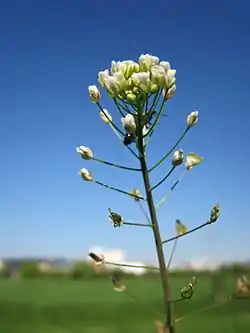薺
See also: 荠 and 萕
| ||||||||
Translingual
| Traditional | 薺 |
|---|---|
| Shinjitai (extended) | 萕 |
| Simplified | 荠 |
Han character
薺 (Kangxi radical 140, 艸+14, 20 strokes, cangjie input 廿卜X (TYX), four-corner 44223, composition ⿱艹齊)
References
- KangXi: page 1063, character 8
- Dai Kanwa Jiten: character 32208
- Dae Jaweon: page 1527, character 34
- Hanyu Da Zidian (first edition): volume 5, page 3315, character 11
- Unihan data for U+85BA
Chinese
| trad. | 薺 | |
|---|---|---|
| simp. | 荠 | |
Glyph origin
Characters in the same phonetic series (齊) (Zhengzhang, 2003)
| Old Chinese | |
|---|---|
| 儕 | *zriːl |
| 麡 | *zriːl, *ʔsliːl, *zliːl |
| 齋 | *ʔsriːl |
| 穧 | *ʔsleds, *ʔsliːls, *zliːls |
| 擠 | *ʔsliːl, *ʔsliːls |
| 躋 | *ʔsliːl, *ʔsliːls |
| 齏 | *ʔsliːl |
| 齎 | *ʔsliːl, *ʔslil |
| 櫅 | *ʔsliːl |
| 齌 | *ʔsliːl, *sʰliːl, *zliːls |
| 隮 | *ʔsliːl, *ʔsliːls |
| 賷 | *ʔsliːl |
| 虀 | *ʔsliːl |
| 濟 | *ʔsliːlʔ, *ʔsliːls |
| 癠 | *ʔsliːlʔ, *zliːl, *zliːlʔ, *zliːls |
| 霽 | *ʔsliːls |
| 齊 | *zliːl, *zliːls |
| 臍 | *zliːl |
| 蠐 | *zliːl, *zlil |
| 懠 | *zliːl, *zliːls |
| 薺 | *zliːlʔ, *zlil |
| 鱭 | *zliːlʔ |
| 嚌 | *zliːls |
| 劑 | *zliːls, *ʔslel |
| 齍 | *ʔslil |
Phono-semantic compound (形聲, OC *zliːlʔ, *zlil) : semantic 艸 (“grass; plant”) + phonetic 齊 (OC *zliːl, *zliːls).
Pronunciation
Definitions
薺
- shepherd's purse
Compounds
|
|
|
Pronunciation
Definitions
薺
- Only used in 荸薺/荸荠 (bíqi) and its regional synonyms.
Compounds
|
|
|
Pronunciation
Definitions
薺
- Alternative form of 茨 (cí, “Tribulus terrestris”).
Japanese
Shinjitai | 萕 |
Kyūjitai | 薺 |
Kanji

薺 (nazuna): the flower of the shepherd's purse.
薺
(uncommon “Hyōgai” kanji, kyūjitai kanji, shinjitai form 萕)
Readings
- Go-on: ざい (zai)←ざい (zai, historical); じ (ji)←じ (zi, historical)
- Kan-on: せい (sei)←せい (sei, historical); し (shi)←し (si, historical)
- Kun: なずな (nazuna, 薺)←なづな (naduna, historical); ひとしい (hitoshii, 薺しい); ととのえる (totonoeru, 薺える)
Etymology
| Kanji in this term |
|---|
| 薺 |
| なずな Hyōgaiji |
| kun’yomi |
/nad͡zuna/ > /nazuna/
Unclear. There are two leading theories, based on older form nadzuna:
- May be derived from natsu na, as in 夏 (natsu, “summer”) + 無 (na, “missing, gone”), from the way the plant dies back in the summer.
- May be derived from nadzuru na, as in 撫づる (nadzuru, “to pet, to pat, to stroke”, the 連体形 (rentaikei, “attributive form”) of Old Japanese verb 撫づ nadzu, modern Japanese 撫でる naderu) + 菜 (na, “edible greens”), from the way the flower clusters may invite handling.
Pronunciation
- (Tokyo) なずな [nàzúná] (Heiban – [0])[1][2][3]
- IPA(key): [na̠zɨᵝna̠]
Noun
薺 • (nazuna) ←なづな (naduna)?
- shepherd's purse, Capsella bursa-pastoris
Usage notes
As with many terms that name organisms, this term is often spelled in katakana, especially in biological contexts (where katakana is customary), as ナズナ.
Hypernyms
- 春の七草 (haru no nanakusa)
References
- 1998, NHK日本語発音アクセント辞典 (NHK Japanese Pronunciation Accent Dictionary) (in Japanese), Tōkyō: NHK, →ISBN
- 2006, 大辞林 (Daijirin), Third Edition (in Japanese), Tōkyō: Sanseidō, →ISBN
- 2011, 新明解国語辞典 (Shin Meikai Kokugo Jiten), Seventh Edition (in Japanese), Tōkyō: Sanseidō, →ISBN
- 1988, 国語大辞典(新装版) (Kokugo Dai Jiten, Revised Edition) (in Japanese), Tōkyō: Shogakukan
Korean
Hanja
薺 • (je) (hangeul 제, revised je, McCune–Reischauer che, Yale cey)
- This term needs a translation to English. Please help out and add a translation, then remove the text
{{rfdef}}.